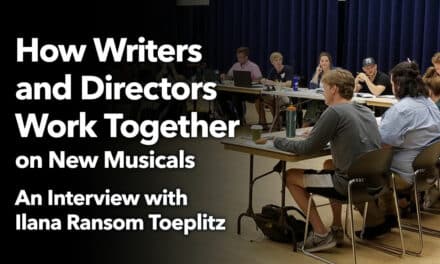by Brent Monahan
It took me fifteen years to write the book and lyrics and compose the music to a musical I named FABLE. I was aware from the outset that a morality play that sounds like it comes out of the 1950s will not these days be the most-attention-getting new piece. However, The Fantasticks & Pippin are perpetual favorites, and certainly Shrek, Spamalot, and Something Rotten are not avant-garde in terms of music or book. I spent three years without success trying to find a home for a fully-staged production. Eventually, I followed the adage, “If you want something done, do it yourself.”
A FABLE song (“Without Music”) was one of the winners of the Fresh Baked Musicals contest. Through this event, which resulted in public performance of the winners, I met Carol de Giere, the author of Defying Gravity, the definitive biography of Stephen Schwartz. She has since become a valued mentor. Carol encouraged the writing of this chronology and analysis of my experience.
As I naively did, other composers and lyricists can waste months and years sending new musical books and music to both professional and community theaters that mount musicals. Returning messages I received were invariably the same: “Your musical doesn’t have any cachet built in. It hasn’t appeared on or off Broadway.” “You haven’t written a previous, well-known musical.” “Not enough posteriors in seats can be generated by a ‘world premiere.'”
Therefore, I needed to self produce a staged reading myself.
Determine your budget.
I determined what level of performances could be presented by establishing a budget to work under.
I settled on an inexpensive staged reading, i.e. mostly reading and singing from music stands, with some blocking and a little choreography, plus lots of props and some costuming. My costs (including printing of books and scores, buying stands, buying many props, paying for the venue and custodial services, advertising in a local monthly magazine and with posters, paying the sound engineer and travel stipends for the actors, and for a videographer to preserve one performance) came to $2,962.
If you’re not able to get together full sets, costumes, blocking, choreography, lighting, etc., you had better at least find the best possible actor-singers to bring your work to life.
Find the right actors.
Go see shows!
I spent more than a year previous to my reading attending many musicals within a one-hour drive of my home. This was to “audition” the leads indirectly. After each performance, I button-holed those persons who were very good and who might fulfill roles for FABLE. I got their contact info and left my calling card.
Use your connections.
At the same time, since I have participated in local musicals over the years, I contacted strong fellow performers. I also called upon the knowledge and connections of theater friends who have performed, directed, or played in musicals ensembles to suggest leads. I posted audition information on Facebook under my own home page. I joined the local Facebook theater groups and listed my musical and role needs there.
I worked up a brief description of my musical and solicited interest among these folk, suggesting a range of rehearsal and performance dates. I attached the book to the email. Since I had solo and duet musical numbers recorded on .mp3, I also tailored attachments based on roles I thought a specific target performer matched.
Consider your income sources.
I made sure I had the cash input lines to be able to afford my budget. Based on the attendances I witnessed at other writers’ premieres, I judged 120 attendees at the two performances would be reasonable. I also settled on the “contribution” fee of $15/adult and $5/student. In all, 144 attended the two performances, but the crew and the cast each got 2 comped tickets (not all used), and a few theater producers and directors also attended free.
The second income stream was from friends scattered around the country who I knew would be interested in FABLE. I asked them to underwrite the videography. In exchange, I would post the show on YouTube for them to enjoy and comment on. This group contributed far more than the cost of the filming. The last income came from advertisements in the program and from selling refreshments. The bottom line was that I came up $340 short, which I was happy to spend in order to see FABLE produced.
Secure rehearsal & performance space.
I was lucky enough to have the use of my church free of charge for rehearsals, but securing a performance venue proved more difficult than I had anticipated. Months before casting, I was assured by someone on the administrative staff of our school district that the junior high school had received a major renovation in the auditorium. While touring the space, I saw that there was no lighting. The seats, sound, stage floor, etc. had been renovated but the administration had taken back the money meant for the lighting. In fact, the school had needed to have a professional lighting crew come in with their equipment in order to put on the winter musical—costing half of what the original lighting budget comprised.
There is a phenomenon related to the ability of an audience to enjoy a show based on the “fullness” of the house. Many empty seats and commensurate lack of laughter and applause negatively relate to the enjoyment factor and other attitudes. Therefore, I did not want to use our high school, with its auditorium that seats 1,000 for a maximum audience of 100 per performance.
I remembered a local church theater I had performed in years earlier which would be helpful in accommodating an inexpensive staged reading. The advantage was that the audience space would be filled at 112 viewers. The disadvantage was that, in the intervening time since I performed there, someone had taken it upon himself to pull out the dimmer board and connect the 8 theater lamps to on/off switches. The rental and custodial fees were reasonable. We had a tech rehearsal the night previous to the first performance. Both lighting and sound problems were exposed. Caveat: To expect to load into a venue with short lead time is an invitation to disaster.
Make the production known.
Even before casting, I had been collecting copies of the local magazines mailed free to each community home. Experience in other promotional efforts proved to me that spending money with the local newspaper was not worth the cost. One of the several enterprises in our county producing a monthly magazine tailors its outreach in seven iterations to sections of the county. I elected to spend $207 on an ad with them. It was placed in two of the publications that supposedly reach 24,000 readers. They were very good about also creating a general interest article on FABLE five weeks early and, a month later, an article on me as a novelist, film writer, and author of FABLE. I know from three inquiry phone calls I received that we garnered at least 7 of our attendees from this effort. This did not recoup the cost but for future selling of FABLE, I have copies of the publications to send out and heightened awareness in the community.
On the first day of rehearsal, I began posting on my Facebook page, information both general and specific about FABLE. I found a wonderful piece of free artwork online that provided an apt “cover.” The lead actor of the performances is a wizard at self-promotion. For free, he created a FABLE site within Facebook. We posted photos, and I wrote articles about the inspiration, how I fit words to music, etc. which were updated about every four days. I exhorted friends to share my postings to their lists.
I made sure the largest established local theater group had our performance dates as a dark weekend so there would be no push-back from their production manager to send out information on FABLE to their massive online mailing list (I had done a lead two years earlier for the company). I dragged out cast and crew contact lists from shows I had performed in, as far as twenty years earlier, and emailed them. I contacted former voice students. I had shared my contacts with a fellow playwright (Emmy winner) months earlier. He returned the favor.
I created 30 posters (8.5 x 11 so as not to take up too much board space and encourage pulling down) and gave two each to the performers (knowing that I had myself never posted more than two when asked). The rest I posted in local churches, delis, a bakery, a pizzeria, two groceries, Starbucks, etc.
Spend money on a videographer.
In looking at where to cut or splurge for an inexpensive staged reading, I deemed videography necessary. First, because I did not have the ability to sit back and watch the two performances, because I was cuing the lighting and sound people. Second, because I wanted the ability to view the show a few days after performances and benefit from a bit of perspective. Third, because I wanted friends unable to attend who have experienced and critical theatrical eyes, to be able to see the show.
You may have a friend willing to record the show for you. This friend must, minimally, know how to use the external microphone jack, have a long extension wire and place at least one quality microphone near the stage to capture anything near to quality.
If you go the route of professional videographer as I did, see if your local high school uses one. Or contact local colleges. Via the executive director of the New Jersey Motion Picture and Television Commission, I was able to link to a recent Communications graduate at Rowan University. He used excellent equipment, had plenty of experience, and hooked into the three microphones for the actors and the board feed of the digitized accompaniments.
Tips on Saving Money when Self Producing a Staged Reading
1. Create specific scores for each cast member. Scripts and scores must be printed and distributed to the cast. There is no need for everyone to have solos and duets in which they don’t participate. Each member got a pre-loaded binder to save rehearsal time.
2. Use recorded accompaniment. Regarding accompaniment, I knew that I could follow three paths. The first would have been to engage a conductor/pianist and either have her/him recruit the other 4-6 instrumentalists or else do this myself. The costs would have been impossible to recoup. The limited amount of time for rehearsal, likewise, would have opened the door to many problems. The second possibility would have been to engage a fine pianist to play a reduced score. I opted for the third avenue. I had built the various accompaniments with the Sibelius notation program, and their Sibelius 7 sounds are not too bad. The main problem is that a program simply runs at the designated tempi; it is unforgiving if the singer gets ahead or behind.
In order to have the performers as skilled as possible with the recordings, I made sure to have them ready weeks before the first rehearsal. I exported them via .mp3 and put them in Dropbox, sharing with all 8 actor-singers. I even provided the overture, entr’acte, etc. so that they could work out the timing of stage business.
3. Order props on the cheap. FABLE requires many props and, for an inexpensive staged reading, some light costuming. In order to keep costs down and since our props were not expected to endure months of handling, I ordered most online from places like China’s Alibaba. This required 6-8 weeks’ lead time. Party City and (in the fall) Halloween stores can be useful resources. I borrowed the robes from our church choir supply.
4. Use friends to run sound and lighting. Two performer buddies backstage handled the feeding of props and the on/off switching of lights. Because of lack of rehearsals, a very well marked script with cues well ahead of actions was supplied them.
5. DIY on ticket handling. I was told Brown Paper Tickets will make your reservations for free online. There is also Ovationtix (Theatremania), and Vendini. However, I could afford no “cut off the top” help, so all my advertising and promotion stated that a soft reservation could be made via a phone call or online address. Payment would be cash or personal check only, to avoid credit charge or PayPal encumbrances. This worked out well. My wife and daughter collected “at the door.” I had created seating grids for both performances for those who reserved.
6. Sell Refreshments. Audiences want something to do during the intermission, other than find the bathrooms. I took advantage of a grocery store sale on water at 13 cents per bottle and sold it chilled at 50 cents. One of my “advertisers” was the best bakery in the county. In lieu of money, it supplied 60 large chocolate-chip cookies, which we price at $1.00. We sold 52.

Next steps? As a lyric from FABLE goes, it’s a matter of putting “one foot in front of the other.”
Need help self producing an inexpensive staged reading? Check out our guides and worksheets here or visit our list of professional services for personalized help.
For others ways to produce an inexpensive staged reading, view How to Self Produce Your Show on a Shoestring Budget



















Thanks for the article. I take it that you did not use equity actors. Was that the case?